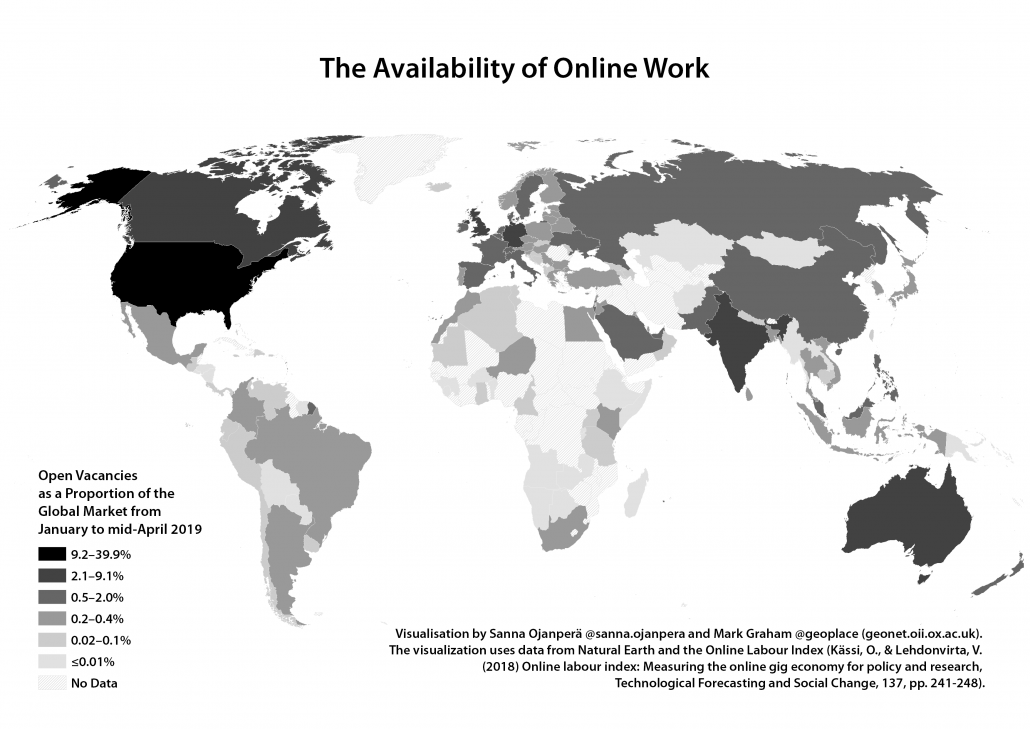In previous blog posts, we’ve mapped the availability of online labour in 2016 [1] and in 2017 [2] using the data provided by the Online Labour Index (OLI) measuring the utilization of online labour platforms [3]. The OLI is based on tracking all projects and tasks posted into a selected sample of platforms, using API access and web scraping.
As we’re interested in monitoring the changing geographies of Sub-Saharan African digital economy, Mark Graham and I wanted to map out the availability of online labour across the world in 2019. In the illustration below (see Figure 1), using a sample of data from January 1 to April 15, 2019, we calculated the number of open vacancies as a proportion of the global online labour market for each country that offers employment on the platforms included in the OLI.

Figure 1. The Availability of Online Work.
Similar to our previous mapping exercises, the map illustrating the availability of online work in the first months of 2019 shows stark patterns of clustered labor demand.
Half of the African countries see no vacancies posted from within their territories. The vacancies posted from the rest of the continent fall below 0.06 percent for each country, except for three countries in Sub-Saharan Africa: South Africa, Niger, and Kenya, and two countries in North Africa: Egypt and Morocco. The online labour market in South Africa, Niger, and Kenya, measures 0.44 percent, 0.32 percent, and 0.18 percent of the global online labour market, respectively, while the online labour market in Egypt and Morocco measures 0.35 percent and 0.17 percent of the global total, respectively.
In the first months of 2019, the majority of the online labour demand is situated in just a few countries with the United States hosting 39.9 percent of the global total, while smaller shares are supplied by the United Kingdom at 8.64 percent, Canada at 7 percent, Australia at 6.68 percent, and India at 5.83 percent. These five countries supply 68.13 percent of the global online vacancies.
In order to illustrate the proportion of workers hailing from around the world, we then mapped the availability of online workers over the same time period, which you can observe in the illustration below (see Figure 2).
Figure 2. The Availability of Online Workers.
Echoing the global divisions in labour supply, the availability of online workers in the first months of 2019 displays uneven geographical concentrations of the global labor supply.
Over half of the African countries have no online workers. The share of workers hailing from the rest of the continent is below 0.11 percent of the global total, except for three countries in Sub-Saharan Africa: Kenya, Nigeria, and South Africa, and three countries in North Africa: Egypt, Morocco, and Algeria. The online labour supply in Kenya, Nigeria, and South Africa measures 0.94 percent, 0.78 percent, and 0.65 percent of the global online labour market, respectively, while the online labour supply in Egypt, Morocco, and Algeria measures 1.03 percent, 0.51 percent, and 0.17 percent of the global total, respectively.
In the first months of 2019, 67.92 percent of the online workers are situated in five countries with India hosting 25.47 percent of the global total, while Bangladesh supplies 12.85 percent, the United States 10.79 percent, Pakistan 10.27 percent, and Philippines 8.54 percent of online workers.
References:
[1] Ojanperä, S. “Mapping the Availability of Online Labour.” Geonet Blog, 21 Oct. 2016, https://geonet.oii.ox.ac.uk/blog/mapping-the-availability-of-online-labour/.
[2] Ojanperä, S . “Mapping the Availability of Online Workers.” Geonet Blog, 5 Oct. 2017, https://geonet.oii.ox.ac.uk/blog/mapping-the- availability-of-online-workers/.
[3] Kässi, O., & Lehdonvirta, V. (2018) Online labour index: Measuring the online gig economy for policy and research, Technological Forecasting and Social Change, 137, pp. 241-248.
Please take a look at our recent research addressing these themes:
(2019) “The global gig economy: Towards a planetary labour market?“, First Monday.
(2018) Data science, artificial intelligence and the futures of work. London: The Alan Turing Institute.
